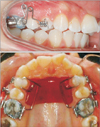Abstract
Objective
Methods
Results
Figures and Tables
Figure 2
Karad's integrated distalizing system. A, Intraoral view from the buccal aspects. B, Intraoral view from the palatal aspects.

Figure 3
Measurements recorded on model photocopies. A, Angular measurements. 1, R4 angle: angle between the maxillary right first premolar axis and the midline reference plane (ML); 2, L4 angle: angle between the maxillary left first premolar axis and ML; 3, R5 angle: angle between the maxillary right second premolar axis and ML; 4, L5 angle: angle between the maxillary left second premolar axis and ML; 5, R6 angle: angle between the line passing through the distobuccal and mesiopalatal cusp tips of the maxillary right first molar and ML; 6, L6 angle: angle between the line passing through the distobuccal and mesiopalatal cusp tips of the maxillary left first molar and ML. B, Linear measurements. 7, U4 distance: distance between the buccal cusp tips of the maxillary right and left first premolars; 8, U5 distance: distance between the buccal cusp tips of the maxillary right and left second premolars; 9, U6M distance: distance between the mesiobuccal cusp tips of the maxillary right and left first molars; 10, U6D distance: distance between the distobuccal cusp tips of the maxillary right and left first molars.

Table 1
Values for the parameters assessed before the initiation of molar distalization with the Frog group and KIDS group

Table 2
Intragroup and intergroup comparisons of transverse dental changes induced by the Frog group and KIDS group

Values are presented as mean (standard error of the mean) or mean difference ± standard error of the mean difference.
Frog group, using the Frog appliance (Forestadent, Pfar zheim, Germany; palatally acting); KIDS group, using Karad's integrated distalizing system (KIDS; buccally acting).
NS, Not significant.
Wilcoxon signed rank test and Mann Whitney U test were used.
Table 3
Intergroup comparison of the amount of rotation per millimeter of sagittal movement in the first premolar and first molar after treatment with the Frog group and KIDS group

Frog group, using the Frog appliance (Forestadent, Pfar zheim, Germany; palatally acting); KIDS group, using Karad's integrated distalizing system (KIDS; buccally acting). R4ang/R4mes and L4ang/L4mes, amount of rotation per millimeter of right and left first premolar mesialization; R6ang/R6mes and L6ang/L6mes, amount of rotation per millimeter of right and left first molar distalization.
SD, Standard deviation; NS, not significant.
Mann Whitney U test was used.




 PDF
PDF ePub
ePub Citation
Citation Print
Print



 XML Download
XML Download